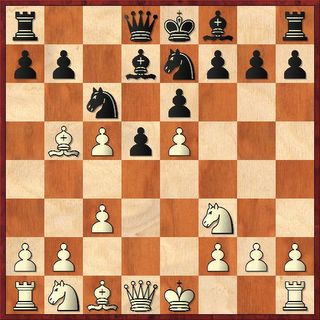Brand New Day Cafe, 1.26.2006
French Defense: Advance Variation [C02]
1.e4 e6
Not sure what possessed me to play the French Defense. This was the first time in 110 USCF rated games as black that I played the French Defense.
2.d4 d5 3.e5 c5
Walt chooses the Advance Variation, which happens to be the line I know best as white.
4.c3 Nc6 5.Bb5
Nf3 is the main line. After, Bb5 if white chooses to exchange the light squared bishop he frequently has difficulty because of his weakness on the light squares, and the vulnerable a6-f1 diagonal.
5...Nge7
Bd7 was also possible here. I played the knight first because if white exchanges, then I will be a tempo closer to castling. Further, the light squared bishop wouldn't be active on c6 anyhow.
6.Nf3 Bd7 7.dxc5
I really didn't expect this. I thought O-O was most likely. Anyhow, White gains the upper hand if black plays anything except Nxe5. Note: the feature in this position that makes this tactic possible is the undefended bishop on b5.

7...Nxe5 8.Bxd7+ Nxd7
It seems like black has a much better position now. White has doubled pawns on the c-file and no pawns in the center. Black on the other hand, has a solid pawn structure and his two center pawns control important squares in the sweet center of the board. 9.0-0?
This loses a pawn. Walt didn't notice that he needed to protect the c5 pawn with either b4 or Be3.
9...Nxc5 10.Be3 Nf5
Rather than retreat whe c5 knight black continues to develop. Now if Bxc5, then Bxc5 and black has gained a tempo toward completing his development.
11.Bd4 Be7
Black continues to develop.
12.Be5 0-0 13.Nd4 Nxd4
I really couldn't find a good home for the knight on f5, so I exchanged here. The best option I had was probably Nd6-Nde4. However, I wanted this outpost for th c5 knight. Regardless, I didn't want my pawn structure weakened, and I realized that no matter how white responded I would be able to play f6 to drive the bishop back or Bf6 to exchange the bishops.
14.Qxd4 f6
I wasn't afraid to weaken the light squares around my king with white's light-squared bishop off the board already.
15.Bg3 Qb6 16.b4
This move leaves a backward pawn on the half-open c-file. Black will use this as a target later. In the meantime, he gets to offer to trade off the queens and then he can bear down on the c3 weakness.
16...Na4
One piece now targets the c3 pawn.
17.Qd1 Qc6
Now 2 pieces attack the c3 pawn, and only 1 defends. White has to protect the pawn now or risk losing it.
18.Bf4 Nxc3
Black takes advantage of white's weakness. However, the pawn is going anywhere, Black should take a move to play e5. This advances a pawn, removes a key weakness in the black pawn structure, and threatens the white bishop. However, I didn't want to have to invent ways of winning the pawn later when it could be done now. Bonus: black now has a connected passer.
19.Nxc3 Qxc3 20.Bd2
Re1 trying to counterattack is probably a better idea. Black is down material, and when you are down material it is usually a good idea to trade off pawns. Furthermore, if black relinquishes the e-pawn, then white can turn black's passed d-pawn into a target.
20...Qd4 21.Qe1 e5 22.Bc3
Not certain I like this move, even though GM Fritz thinks it is best. The black plan has to be to push pawns until the passer promotes. The black queen was blocking the advance of the passed pawn. After this move, the queen will have to move allowing d4. For the record, I like a3 better for white here.
22...Qc4 23.a3 Rac8
Taking firm control of the c-file and doubling up on the white bishop.
24.Bd2 Qb3 25.Qe3 Qxe3 26.Bxe3
The queen exhange plays into black's hands. The threat of the pawn chain looms larger with each pair of pieces that are traded off the board.
26...d4 27.Bd2 Rc2
This allows black to double his rooks on the c-file with tempo.
28.Rfd1 Rfc8 29.Kf1 a6 30.Rac1 f5
I played f5 to give my bishop the f6 square. Furthermore, i need to get my pawns off the dark squares to transform my bad bishop into a good bishop.
31.Rxc2 Rxc2 32.Ke1 Kf7 33.Rc1 Rxc1+ 34.Bxc1 Bf6 35.f3 Ke6
The king is headed to b3.
36.Kd2 Kd5 37.Bb2 e4 38.f4 Kc4 39.g3 Kb3 40.Bc1
White relinquishes the fight for the long diagonal.
40...b5
This move probably wasn't necessary, but I was looking to get things locked up on the queenside before continuing my effort to promote the d-pawn.
41.h3 d3
Notice the power of the f6 bishop now that the diagonal is free of pawns.
42.g4 Bc3+ 43.Ke3
Now it is all over. The king had to protect the bishop and keep the black king out of c2.
43...Kc2 44.gxf5 Kxc1 45.Kxe4 0-1

No comments:
Post a Comment